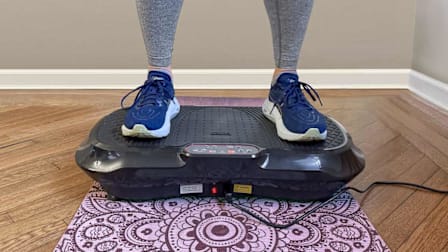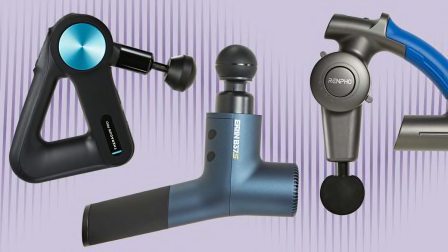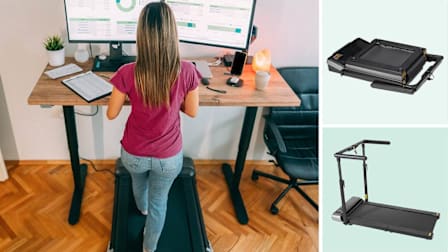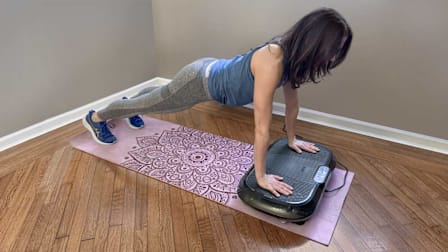How to Set Up Your Ideal Home Gym
It's easier than ever to avoid the drive to a gym. Here's advice for designing a great workout spot no matter how little space you have.
When you shop through retailer links on our site, we may earn affiliate commissions. 100% of the fees we collect are used to support our nonprofit mission. Learn more.
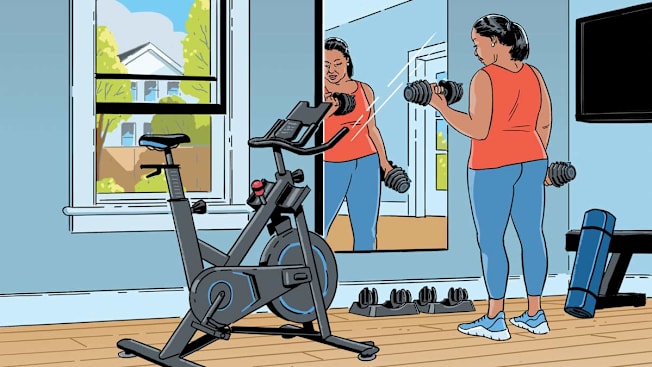
Exercise is critical for your physical and mental health, but it’s harder to do if being outdoors seems unappealing or unsafe. And gym memberships can be pricey. The average monthly cost ($65) was up 9 percent in 2023, according to the Health and Fitness Association.
Enter the home gym. “In the amount of time it would take you to get to a gym, you can be done with your home workout,” says Tom Holland, an exercise physiologist and trainer in Darien, Conn.
The key to building a home gym you’ll actually use (and even enjoy) is thinking about what you want to spend and how much time and space you have—whether it’s a corner of your bedroom or a fully finished basement.
The Bare-Bones Home Gym
Cost: Less Than $200
“With the low-budget option, you’re spending on tools to help you build strength, stability/balance, flexibility, and mobility,” says Gretchen Zelek, a fitness instructor in Los Angeles. At this price, the cardio aspect will be simple, often involving moves like jumping jacks or marching in place.
In addition to the equipment listed here, you may want to have a TV or laptop in your gym area so that you can use a workout app or turn on your favorite show. It’s also nice to have a mirror to check your form, ample lighting, and good ventilation, says Ayland Letsinger, PhD, who chairs the Strategic Health Initiative on Aging for the American College of Sports Medicine. While doing strength moves, you can sit on a stability ball, perch on a sturdy chair, or simply stand.
Resistance bands/tubes ($18): These large rubber bands increase in resistance the more you stretch them. You can usually buy them in sets of thin to thick, reflecting different difficulty levels, similar to having a set of dumbbells except they’re much cheaper. Look for bands with handles, which are easier to grip than flat bands. They can be useful for some physical therapy moves as well.
Stability ball ($30): These inflatable balls can function as a weight bench and an excellent tool for various resistance exercises, especially core moves, Holland says. They range in size, so get one that suits your height. The wobble aspect of using a ball means you have to engage more core muscles to keep yourself stable.
Ropeless jump rope ($10): Weight-bearing exercises help keep bones strong, and jumping rope burns about 12 calories per minute (roughly twice as much as walking). Jumping rope is generally an outdoor activity, but you can do the same motion without the actual rope (so there’s no tripping).
Balance pad ($27): To help build balance, stand on this rectangular block of foam during strength moves. Or try closing your eyes for 30 to 60 seconds while balancing on one foot.
Stretching strap ($16): If better flexibility is one of your goals, a stretching strap can come in handy. You simply hook the center or one of the built-in loops around your foot or leg (there are different types of straps) and use your hands to adjust the intensity of the stretch.
Mat ($20-$100+): You don’t absolutely need a mat, but you might not enjoy lying on the floor. A simple yoga mat will give you a clean, slightly cushioned spot for strength moves and stretches.
How to Use This Setup
A circuit-style approach can keep you engaged and your heart rate elevated.
Here’s how it works: After warming up with a few minutes of cardio (jumping jacks, marching in place, jumping rope, etc.), do a set (10 to 12 reps) of a strength move (with resistance bands, for example), then move on to another exercise (like pushups), and then another. After the last rep of the third move, do another 30 seconds to a minute of cardio. If you need rest between sets, take a minute.
Continue with this pattern for 20 to 30 minutes (or longer), then use the strap to help you stretch when you’re finished.
Yoga mat:
Iuga Pro Non-Slip Yoga Mat ($60-$66)
Shop: Amazon
Resistance bands:
First Place Safety Toners ($16-$24)
Shop: Perform Better
Balance pad:
ProsourceFit Exercise Balance Pad ($27)
Shop: Amazon, Home Depot, ProsourceFit, Walmart
The Next-Level Home Gym
Cost: $600-$2,000
Start with the basic gym tools just mentioned, then invest in a simple cardio machine and some dumbbells to allow for greater variety. Most critical: Look for high-quality equipment. You can find inexpensive cardio and weight systems, but they probably won’t last.
Exercise bike ($200–$1,500+): There are several types to choose from: recumbent, upright, studio (the kind you’ll find in an indoor cycling class), and more. An exercise bike lets you get an intense workout, but you can also take it slowly if you’re injured or just starting out, says Nadya Swedan, MD, a physiatrist in New York City and a clinical assistant professor of physiatry at the Zucker School of Medicine at Hofstra University. Bikes often cost less and take up less space than a treadmill, and you can go bare-bones or pick a connected bike that offers virtual classes and scenic rides.
Adjustable dumbbells ($180-$700+): A bunch of weights can be pricey, and storing them can be a hassle. Adjustable dumbbell sets allow you to go from low to high resistance (the equivalent of several pairs of dumbbells in one) with one set of grips in a relatively small amount of space. They’re much easier for at-home weightlifting, Holland says.
Suspension trainer ($230): These strappy, portable devices help you increase or even decrease the challenge of moving your own body weight as you do pushups, lunges, and more with your arms or feet in the handles. All you need is a sturdy anchor point or closed door and you’ve upgraded your workout. Some come with an app to help you get the hang of using the device.
How to Use This Setup
You can do the same circuit-style workout, adding in weight exercises with the dumbbells or suspension trainer. Lengthen your workouts by making your cardio intervals a little longer on the bike. Or make them more boot-camp style, where you alternate riding on the bike for 5 minutes with 5 minutes of resistance training (using the dumbbells and/or the suspension trainer). Repeat the two for as long as you want or lengthen the time for each to 10 minutes. The back-and-forth makes it more interesting than doing long blocks of cardio or weights.
You can challenge yourself to increase the speed or incline on the bike for 15 to 30 seconds (before returning to an easier pace), which is called interval training, or try to hit a certain distance within one time frame and then attempt to beat it the next time.
The Full Gym Experience
Cost: $5,000-$12,000 or More
With a bigger budget, you can opt for the bells and whistles and allow yourself more options for cardio cross-training. Just think about what you enjoy doing at the gym and get that equipment for home. If you’re a fan of Pilates or barre classes, you can invest in a reformer or barre. With a full setup, you can even hire a personal trainer or physical therapist to come to your home, potentially splitting the cost of sessions with a friend.
Treadmill ($1,000–$6,000+): Having one of these ensures that you can walk, jog, or run whatever the weather. Choose from folding or nonfolding models, and look for incline options so that you can challenge yourself with hills as well as speed. Make sure you get a sturdy machine with an emergency shutoff in case of a fall. (Skip walking pads, many of which our testers have found to be unsafe and unreliable.) As with bikes, a connected model (such as one from NordicTrack or Peloton) can provide all sorts of creative workouts and even allow you to virtually enjoy scenery from around the world.
Rower ($700-$3,000+): A rower can work your entire body at once, Letsinger says: arms, core, and legs. That’s why it’s a good partner to a treadmill or bike, which focuses on the lower body. It’s one of the only common cardio machines that requires you to use your upper body. An elliptical is a somewhat gentler option, but it doesn’t provide the same sort of upper-body workout.
Medicine Ball ($85): Weighted, soft-sided balls are another way to get resistance work, especially for your core, into your routine. You can throw them against a brick or cement wall or down on a sturdy floor (if you don’t have neighbors below).
Kettlebells ($40): These weighted balls with handles—hold tightly while you swing one—give you more resistance training options and also help build grip and core strength, and cardio fitness.
How to Use This Setup
The high-end gym is really about having options for cardio and strength training. Try doing 10- to 15-minute chunks on each machine, back-to-back, putting a few sets of weight moves in between. You can also consider alternating from day-to-day which cardio machine you use.
By now you probably get the idea that the key to getting the most out of your home gym—in addition to picking tools you enjoy—is staying engaged, getting creative to stave off boredom, and adjusting the intensity of exercise so that the level of difficulty feels right to you.
Workout Classes in Your Home Gym
A home gym makes it easier to exercise, but you still have to turn it into a habit—otherwise your new gear might gather dust. Apps and programs that offer guided workouts and virtual group classes offer motivation and fresh ideas.
Free Videos
If you’re just getting started with strength training, search for the Mayo Clinic’s strength training “How-To Video Collection” for some helpful basics. Ready for more? The YMCA at Home YouTube channel offers dozens of free guided routines for cardio, strengthening, and stretching. If you want more variety and goal-oriented programs, the free Nike Training Club app offers a library of trainer-guided workouts for everything from yoga to strength, and you can sort by the equipment needed to match what you have at home.
Paid Apps and Programs
Your cardio machine—a NordicTrack, Peloton, or ProForm bike or treadmill, for example—may come with a paid subscription that gives you access to a vast library of scenic runs/rides and fitness classes that often go far beyond cardio. Peloton offers live virtual classes. You can pay to access these apps even if you don’t have a cardio machine. Peloton will cost you $24 per month; iFit Train is $15 per month. Stand-alone apps like Zwift ($20 per month) and Kinomap ($12 per month) also offer options for community-building and guided workouts.
Editor’s Note: This article also appeared in the January/February 2025 issue of Consumer Reports magazine.

















